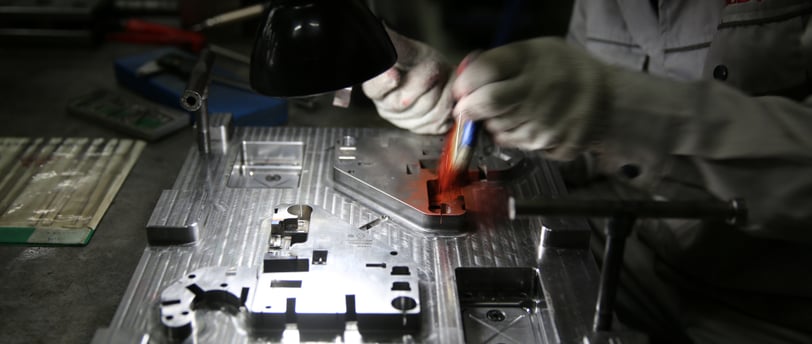Types of Stamping Dies and Selection Criteria
1/28/2025


Introduction to Stamping Dies
Stamping dies are specialized tools used in the manufacturing process to cut, shape, or form materials, primarily metals. Their primary function is to facilitate the efficient mass production of various metal components by employing pressure to shape the material into the desired form. This process is essential in industries such as automotive, electronics, and aerospace, where precision and consistency are paramount in meeting the rigorous standards of these sectors.
The technology behind stamping dies has evolved significantly over the years, allowing for greater complexity and precision in the shapes and designs produced. Stamping die technology encompasses the various types of dies, presses, and related equipment used to create components through processes such as punching, bending, and forming. Understanding the various types of stamping dies available is crucial for manufacturers, as it informs their selection process based on the specific requirements of their projects.
There are several types of stamping dies, each designed for different purposes and manufacturing goals. For instance, progressive dies are utilized in operations where multiple steps are performed in a single stroke, thereby enhancing production efficiency. Conversely, single-station dies may be applied for more straightforward tasks involving less complex shapes. The choice of stamping die directly affects not only the quality of the final product but also the overall efficiency of the manufacturing process. Therefore, a comprehensive understanding of stamping dies is crucial for any organization involved in metal fabrication.
The significance of stamping dies in production cannot be overstated. They ensure that components are produced with accuracy and can significantly reduce production times while maintaining a high standard of quality. In this dynamic landscape, staying informed about the various types and functions of stamping dies will greatly benefit manufacturers seeking to optimize their operations and enhance the quality of their products.
Types of Stamping Dies
Stamping dies are critical tools in manufacturing processes, designed to shape or cut materials into specified forms. There are several major categories of stamping dies, each serving unique purposes depending on the project requirements.
One prevalent type is the progressive die. This die facilitates a sequence of operations in a single cycle, advancing the material through a series of stations. The advantage of using progressive dies lies in their ability to produce complex parts efficiently. Industries like automotive often favor progressive dies for high-volume production, as they minimize handling and reduce cycle time. However, the initial setup costs can be substantial, and they may not be the best choice for low-volume tasks.
Compound dies, another common type, perform multiple operations simultaneously. They can cut and form material in one motion, making them suitable for simpler parts. The main advantage of compound dies is their efficiency in reducing the number of operations required. However, their design is typically more complex, which may introduce limitations in terms of flexibility for varying part designs. Industries engaged in producing basic components often utilize compound dies for their quick turnaround capabilities.
Lastly, single-station dies are designed for one operation at a time. This simplicity makes them easier to work with and ideal for prototyping or low volume production where variations in parts are frequent. They are less cost-effective for mass production due to their slower operational pace. Nonetheless, single-station dies are advantageous in terms of setup and maintenance, allowing for quick adjustments and changes in part design.
Understanding these types of stamping dies—progressive, compound, and single-station—enables manufacturers to choose the most suitable die for their specific needs, optimizing both efficiency and cost-effectiveness in their production processes.
Factors to Consider When Selecting Stamping Dies
When selecting the appropriate stamping dies for manufacturing processes, several critical factors must be considered to ensure optimal performance and results. Firstly, the material type of the die is paramount. Stamping dies can be made from various materials, including steel, carbide, and plastics, each offering different levels of hardness, durability, and resistance to wear. The selection of material should align with the intended application, as it can significantly impact the longevity and effectiveness of the die.
Secondly, thickness is an essential determinant. The thickness of the material being stamped can influence the die design and construction, as thinner materials may require more intricate designs while thicker materials benefit from robust die structures. Understanding the material thickness will help in determining the die’s strength and forming capabilities.
Additionally, the complexity of the part design plays a crucial role in the selection process. More intricate designs may necessitate specialized dies, which can increase manufacturing costs and lead times. Conversely, simpler designs can be accommodated with standard dies, resulting in lower costs and faster production timelines.
Production volume is another critical factor when selecting stamping dies. High-volume production may justify a more significant investment in complex dies to ensure efficiency and reduce per-piece costs. In contrast, low-volume projects might benefit from simpler, more cost-effective die solutions. Moreover, understanding the budget constraints is essential, as cost implications can vary significantly based on die complexity, material choice, and intended lifespan.
Other considerations include die maintenance, as regular upkeep is necessary to sustain operational efficiency and extend the die's life. Compatibility with existing machinery should also be evaluated, as using dies that can integrate seamlessly with current equipment reduces downtime and eases the operational transition. By addressing these various factors, manufacturers can make informed decisions that align with their specific project requirements and operational goals.
Best Practices in Die Selection and Maintenance
Selecting the appropriate stamping die is crucial for optimizing production efficiency and ensuring quality output. One of the best practices in die selection involves evaluating the intended application and the materials to be used. It is essential to consider factors such as material thickness, type of metal, and the complexity of the part being produced. Additionally, conducting a thorough analysis of the planned production volume can guide the selection of a die that offers the best combination of durability and cost-effectiveness.
Routine inspections of stamping dies play a pivotal role in maintaining their performance. Establishing a scheduled maintenance program can help identify wear and tear or damage before they lead to significant operational disruptions. Inspections should encompass all aspects of the die, including the cutting edges, alignment, and guide systems. Implementing preventative maintenance strategies, such as lubrication and cleaning, can also significantly prolong the die's lifespan.
Proper storage of stamping dies is another essential consideration. Storing dies in a controlled environment helps protect them from environmental factors such as moisture, dust, and corrosive elements. Custom storage solutions, such as specialized racks or containers, can minimize the risk of damage while making it easier to access dies when needed.
Furthermore, keeping abreast of advancements in tooling technology is vital. As new materials and processes emerge, it may be advantageous to evaluate current dies against these advancements. Upgrading to more efficient dies or modifying existing ones can enhance production efficiency and reduce operational costs.
Industry case studies illustrate the efficacy of these best practices. For instance, a leading automotive manufacturer implemented a preventive maintenance program that resulted in a 20% decrease in downtime due to die failures. These successful strategies highlight the importance of both selecting the appropriate die and maintaining it effectively to maximize production capabilities.
